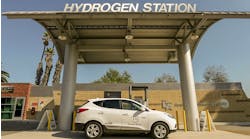In 2007, schools and universities allocated billions of dollars to build education facilities. Responsible administrators strive to spend those funds wisely, but over the years, educators and community members haven't always agreed on what constitutes wise spending. In the Baby Boom years, the accelerating demand for space led many schools and universities to spend those funds on classrooms built quickly and cheaply. A generation later, those institutions and their constituents learned that the old saying was true — you get what you pay for.
In recent years, many administrators and designers have come to embrace a different concept of what constitutes a wise expenditure on education facilities. The initial cost of constructing space still is important and closely monitored. But, having experienced buildings from the 1950s and 1960s that deteriorated prematurely, schools and universities also are paying more attention to the cost of operating and maintaining those spaces over the life of a facility.
The long-term approach is a key foundation to green design. A school or university may be able to build facilities for less by addressing only the immediate, pressing space needs. But often the result is a facility that costs more to operate, requires excessive maintenance, and creates health problems for students and teachers.
Green design and construction adds another element to that long-term approach. Those who follow green tenets are concerned not only about the long-term well-being of a particular school or university and its students and staff, but also about the well-being of society at large and the whole planet. Here are 10 of the benefits that green school advocates frequently cite as reasons that schools and universities should embrace green design:
- Save energy
Though scientists and politicians may disagree on how long the Earth can sustain the amount of energy being consumed by the world's citizens, what is not in dispute is that the Earth's resources are finite. The less that we use now, the more of what we have will last. Education facilities that are designed and built to use less power for heating, cooling, lighting and operating machinery can make a significant contribution in the drive to conserve energy.
The 2006 report, “Greening America's Schools,” produced by Capital E and sponsored by the American Federation of Teachers, American Institute of Architects, American Lung Association, Federation of American Scientists and the U.S. Green Building Council, looked at 30 sustainably designed schools and found that on average they used 33 percent less energy than conventionally designed schools. The Dalles (Ore.) Middle School, which received gold LEED certification from the Green Building Council after it opened in 2002, uses 50 percent less energy than a conventional school, the report says.
- Save water
Having water available is critical to the smooth functioning of a school. Education institutions that use green strategies are able to reduce significantly the amount of water consumed on their campuses. That is a worthwhile goal at all times, but is especially critical when regions of the country are experiencing drought, as is the case now in the Southeast. Because of the severe drought this fall, the University of Georgia has cut back on irrigation, restricted the use of water in its labs and research buildings, and even asked football fans not to flush toilets during a game at the university's stadium. The 30 schools examined in “Greening America's Schools” used 32 percent less water than conventionally designed schools.
Among the strategies schools can use to conserve water: no-water urinals, low-volume toilets, low-flow faucets and automatic shutoff valves. Planting drought-resistant vegetation on a campus reduces the amount of water needed for irrigation. Rainwater-collection systems capture stormwater runoff in ponds or cisterns for later use in irrigation. Some schools also capture grey water from showers or kitchens so it can be reused to water plants and lawns or flush toilets.
- Save money
If conserving energy and water doesn't persuade some education administrators to adopt green strategies, they may be convinced by how that conservation affects their bottom lines. Using less water and energy means spending less on water and energy. The financial hurdle that has slowed the acceptance of green design and construction among administrators is the so-called “green premium” — the additional initial cost associated with including sustainable strategies in a construction project.
Proponents and opponents have argued about whether such a premium exists and, if so, how large it is. The “Greening America's Schools” study found that in the 30 schools researchers examined, the additional cost attributed to sustainable design and construction strategies averaged 2 percent, or $3 per square foot. That additional cost is more than offset by what green practices save schools. “Lower energy and water costs, improved teacher retention, and lowered health costs save green schools directly about $12 per square foot,” the study says. In addition, the community at large saves because of the lower cost of public infrastructure, lower air and water pollution, and a better educated workforce.
- Reduce pollution
Using the findings that green schools consume 33 percent less energy than conventionally designed schools, “Greening America's Schools” calculated the annual effect of having a green school instead of a conventional school: Emissions of nitrogen oxide would decrease by 1,200 pounds; sulfur dioxide emissions would drop by 1,300 pounds; coarse particulate matter, a principal cause of respiratory illness, would fall by 150 pounds; and the amount of carbon dioxide produced would drop by 585,000 pounds.
“As the health, financial and social costs of global warming in particular continue to mount, cutting greenhouse gases through energy efficiency and greater use of renewable energy will become an increasingly valued benefit of greening buildings,” the study says.
- Improve health
Green design and construction result in an education environment that is more healthful for students and staff. A green school is designed to have better indoor air quality, improved climate control, more daylighting and better acoustics. Maintenance staffs that use green cleaning products reinforce the environmentally friendly building design by using products that are safer for students and staff. The results are fewer sick days, better productivity because of improved environmental conditions and greater retention of teachers because the school facilities are not causing them to become ill.
“It makes sense that a school specifically designed to be healthy and characterized by daylighting, less toxic materials, improved ventilation and acoustics, better light quality and improved air quality would provide a better study and learning environment,” the “Greening America's Schools” study says.
- Provide educational opportunities
The purpose of schools is teaching and learning, and a green school gives numerous opportunities to learn about ecology, resource management, and the effect construction and design decisions have on the environment.
The presence of green design and construction elements enables the facility itself to teach lessons about energy consumption and conservation, or alternative forms of energy such as solar panels or wind turbines. Schools can install monitors to measure use of water and utilities to see how green strategies affect consumption, or students can plant their own vegetable gardens to provide their own lunch materials. In all of these examples, students get a hands-on lesson showing how their actions affect available resources.
The design of a building can include construction elements exposed so students can learn how the choice and placement of features and materials affects the amount of resources consumed and whether they are being used efficiently.
- Use local resources
Sustainable design strategies consider the effect of all elements of a building project. That means not just looking at the price of purchasing supplies and materials, but the cost of transporting those items to a job site. Even if those shipping costs are not borne by the school or university, the resources consumed to carry out the shipping are a factor in determining the environmental impact of a project.
So, green principles call for builders to give precedence to locally produced materials. In addition to consuming less energy, a project that uses local materials stimulates the local economy and benefits the community in which a school operates.
- Reuse materials
The aspect of green design most familiar to the general public is recycling. The concept is simple: When material is reused, society is spared the financial and environmental costs of producing new material. It's true for the soda pop cans set out on the curb every week in recycling bins, and it's true for the tons of materials that are part of the recipe for building a new education facility.
Using recycled materials as much as possible and recycling the waste generated by the project are key elements of sustainable design. “Greening America's Schools” found that a typical green building project diverts between 50 and 75 percent of its construction and demolition waste away from landfills for reuse. The 30 green schools studied in the report recycled an average of 74 percent of their construction waste.
In announcing plans last month for a new school in Lower Manhattan for grades preK to 8, New York City officials said the project would recycle 80 percent of construction waste and use 12 percent recycled content in construction materials.
- Receive grants and subsidies
Numerous organizations and government agencies offer grants and incentives to schools that incorporate sustainable design principles in their construction and maintenance programs.
For instance, as part of a green schools initiative, the Massachusetts Technology Collaborative is offering schools $15 million in grants to pay for environmentally friendly systems such as solar electric panels and wind turbines, and other clean energy technologies, as well as green building design and planning assistance.
In California, voters in 2006 approved $100 million in high-performance incentive grants for green school construction. The state's Department of General Services' Office of Public School Construction will rate the high-performance attributes of school construction projects and award the incentives.
- Exhibit leadership and social responsibility
Besides the financial benefits and environmental improvements schools and universities can realize by adopting sustainable design and construction strategies, administrators and educators can show their students and society at large that as leaders, they recognize the serious consequences that could result if people do not adopt more environmentally sensitive practices.
The presidents of more than 430 colleges and universities have acknowledged their roles as leaders in the fight for a better environment by signing “American College & University Presidents Climate Commitment,” in which they promise to pursue sustainability and carbon neutrality on their campuses.
“We believe colleges and universities must exercise leadership in their communities and throughout society by modeling ways to minimize global warming emissions, and by providing the knowledge and the educated graduates to achieve climate neutrality,” the commitment states. “Campuses that address the climate challenge by reducing global warming emissions and by integrating sustainability into their curriculum will better serve their students and meet their social mandate to help create a thriving, ethical and civil society.”
Kennedy, staff writer, can be reached at [email protected].
Top 10 reasons to go green
- Save energy.
- Save water.
- Save money.
- Reduce pollution.
- Improve health.
- Provide educational opportunities.
- Use local resources.
- Reuse materials.
- Receive grants and subsidies.
- Exhibit leadership and social responsibility.




